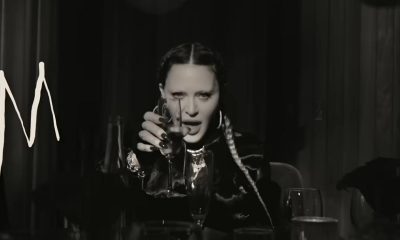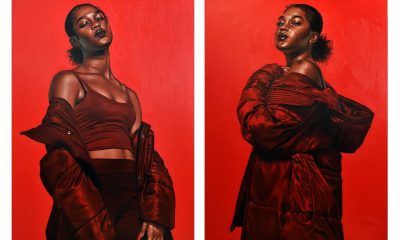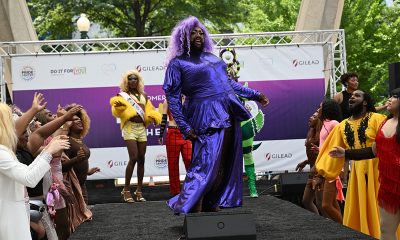a&e features
Baltimore Museum of Art unveils massive installation by Mickalene Thomas
Out queer/lesbian artist finds inspiration in ‘60s, ‘70s liberation, aesthetics
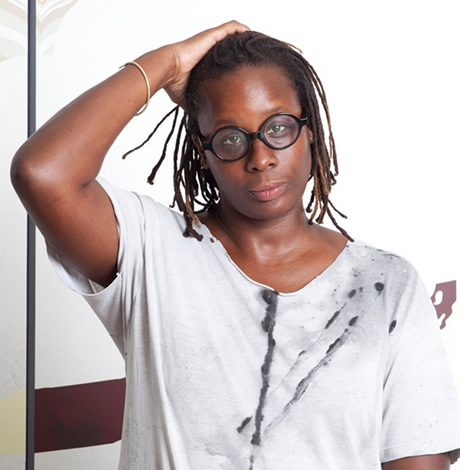
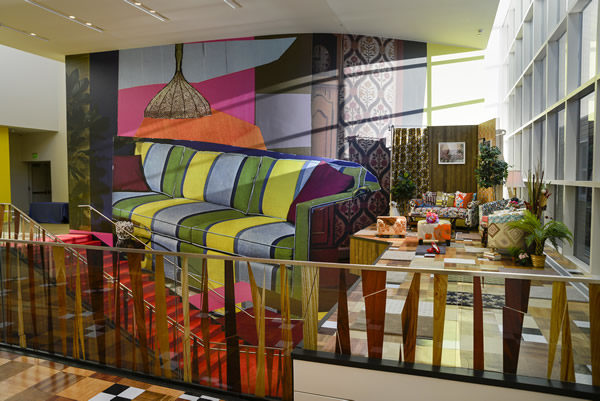
Since he became director of the Baltimore Museum of Art three years ago, Christopher Bedford has made it clear he wants to expose visitors to diverse voices and perspectives.
One sign of his effort is an 18-month exhibit that opened this fall featuring Mickalene Thomas, a 48-year-old black queer/lesbian artist from Camden, N.J.
In “Mickalene Thomas: A Moment’s Pleasure,” the artist has taken over a part of the museum that isn’t typically used for exhibits, the two-story East Lobby, and made it the backdrop for her work. She also brought in more than two dozen other artists to be part of her installation.
“Mickalene’s ambitious reinstallation of the East Lobby offers a new and exciting aesthetic experience — one that engages the senses at every turn and offers the community a dynamic new space in which to connect with each other, the work and the museum,” Bedford says. “It is transformative in its own right as an astounding work of art and in its revisioning of what the museum can and should feel like to visitors.”
Whereas museum architect John Russell Pope wanted the museum to be Baltimore’s porch when he designed the original building in the 1920s, Bedford says, “I think what Mickalene Thomas has conceived is Baltimore’s living room.”
Thomas, who is often included in lists and articles focusing on the country’s leading queer artists, creates visually and conceptually layered compositions using a wide range of media. Best known for her elaborate paintings composed of acrylic, enamel and rhinestones, she also makes collages, photographs, videos and room-sized installations.
Her genre-busting work includes portraits, landscapes and interiors that blend art history and pop culture to explore themes of gender, identity, sexuality, race, beauty, equity, power, “sense of self” and the human body. She looks at femininity and womanhood against the backdrop of the civil rights movement in the U. S. and the societal upheaval of the 1970s and 1980s.
The Baltimore exhibit is one of three she has on display right now, along with others at the Contemporary Art Center in New Orleans and the Bass Museum of Art in Miami Beach. Her work can be found in the permanent collections of New York’s Museum of Modern Art, Solomon R. Guggenheim Museum and Whitney Museum of American Art, as well as Washington’s Smithsonian American Art Museum and many others.
A graduate of the Pratt Institute and the Yale University School of Art, now based in New York, Thomas has also become a celebrity and a mentor for young artists. She’s one of the founders of the Josie Club, a group of “black queer women.” She has been chosen to design the custom outer “wrap” for a Rolls Royce Red Phantom that Sotheby’s is auctioning to help the global charity known as (RED) raise funds to eradicate AIDS. The Los Angeles Times said she is to contemporary painting what Daft Punk is to music, “one of the more original remix artists working today.” Smithsonian Magazine called her a “Renaissance rock star.”
At the Art Basel Miami festival this month, Thomas and her partner and collaborator Racquel Chevremont were spotted all over town, from the opening of Thomas’s show at the Bass Museum to the debut of the new Rubell Museum in Allapattah, another high-profile collection that includes her work.
At the Baltimore Museum of Art, Thomas has turned the East Lobby into a community gathering spot that doubles as a showcase for her work and those of others in the exhibit. It’s one of the largest commissions she’s ever undertaken and the first major presentation of the museum’s 2020 Vision initiative, which highlights female-identifying artists
The transformation starts on the exterior, where she has installed a vinyl mural that looks like three oversized Baltimore row house facades, one in brick, one with siding and one in FormStone.
The residential theme continues inside the entrance. Every surface of the lobby has been covered with materials that evoke a domestic setting, including wallpaper, carpet, linoleum flooring, faux wood paneling and a wall of house plants.
On the second-level mezzanine, Thomas created a tableau of a living room and then juxtaposed it with a large mural of a sofa and hanging lamp. Her vivid colors, geometric patterns and textures bring to mind the aesthetics of the 1970s and 1980s, a period she sees as particularly significant for African Americans.
On the Murray J. Rymland Terrace, an area not usually accessible to the public, Thomas created a temporary “Terrace Gallery” that consists of two rooms, one fitted out like a den with a large TV and one that resembles a club basement.
These spaces are filled with works by 16 other artists. Halfway through the show, the works now on display will be replaced with works by 16 more artists. A back door in the club basement leads to a small outdoor space, complete with Astroturf, that’s reminiscent of the sort of postage stamp-sized back yards many Baltimore row houses have.
The East Lobby of the museum’s 1982 wing has typically served as a circulation space leading to the visitor information counter, the gift shop, Gertrude’s Chesapeake Kitchen restaurant and galleries elsewhere in the building.
Thomas says she gave the lobby a more residential feel as a way of encouraging artists and visitors to make it their own space, and do what they want with it.
She said other artists might have created a single sculpture or painting in the lobby, but she wanted to do something that was “more transformative” and inviting to the community at large.
“How does one do that in this space?” she says. “It’s about really changing the façade. It’s about changing the interior. But also allowing this lobby to be open in a way, where all of my touches are along the side, on the periphery. So what you do, you open up the space architecturally and you allow this now to be performative, occupied space for the organization and community that decides to come in here to take over.
“The organization and artists that we’re working with, this gives them opportunity to use this as their platform, to use this space, this lobby, as their space,” she says. “To take ownership of that, whether it be a dance performance that could be here, whether it could be musicians … or a place of conversation. This becomes their landscape, their museum, that they can transform and use as their living room.”
Thomas says the Baltimore exhibit reflects a “black aesthetic” that’s evident in all of her work.
“Black aesthetic is black art,” she said. “Black living. Black love. Black materials. Black poetry. Black literature. Black music.”She used colors and materials that evoke the 1970s, she said, because she believes that was a key period for blacks and women, in terms of civil rights and artistic expression.
“Historically, when you think of black women owning their beauty, their hairstyles, when you think of styles and music, everything happened in the late ’60s, ’70s,” she says.
She takes a holistic approach to presenting art. At the public opening of the exhibit, she designed her own signature cocktail for the event and offered custom nail art in a pop-up nail shop. Her installation also includes costumes for museum staffers working in the lobby, created by Dominican-born fashion designer Jose Duran.
The other artists she enlisted range from some who are nationally prominent and have been widely displayed, to others who have never had work shown in a major museum before. All have ties to Baltimore and their work includes paintings, prints and drawings as well as videos. The Terrace Gallery will also be a setting for a series of events, including film screenings, artist talks, performances and workshops.
Featured artists include Derrick Adams, Zoe Charlton, Theresa Chromati, Dominiqua Eldridge, Devin Morris, Clifford Owens and D’Metrius John Rice. Videos are by Abdu Ali and Karryl Eugene; Erick Antonio Benitez, Nicoletta Darita de la Brown, Kotic Couture, Markele Cullins, Emily Eaglin, Hunter Hooligan and TT the Artist.
“A Moment’s Pleasure” is the first presentation in a new initiative called the Robert E. Meyerhoff and Rheda Becker Biennial Commission, which will bring a new exhibit to the museum’s east lobby every two years.
Meyerhoff and Becker established the commission in 2018 to give contemporary artists a platform within the museum to carry out ambitious projects that engage the community, in one of the most accessible parts of the building. According to Bedford, the goal is “making the museum experience more welcoming to a broader range of visitors through exceptional art.”
Bedford curated the Thomas exhibit with Meyerhoff-Becker curatorial fellow Cynthia Hodge-Thorne and curatorial assistants Katie Cooke and Carlyn Thomas. He praises Thomas for including others.
“Many other artists would have taken a commission like this and it would have been all about them, all the time. In the case of Mickalene Thomas, it is not all about her, all the time. In fact, there is an ego-less dimension to this installation that I think is timely, laudable and quite uniquely her.”
“Mickalene Thomas: A Moment’s Pleasure” is a free exhibit that will run through May 2, 2021. Located at 10 Art Museum Drive in north Baltimore, the museum is open Wednesday through Sunday from 10 a.m.-5 p.m.
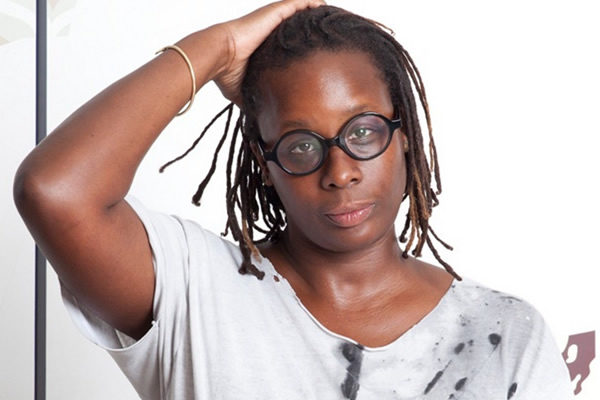
a&e features
Doug Spearman takes his chance
‘Noah’s Arc: The Movie’ debuted on Paramount+ last month
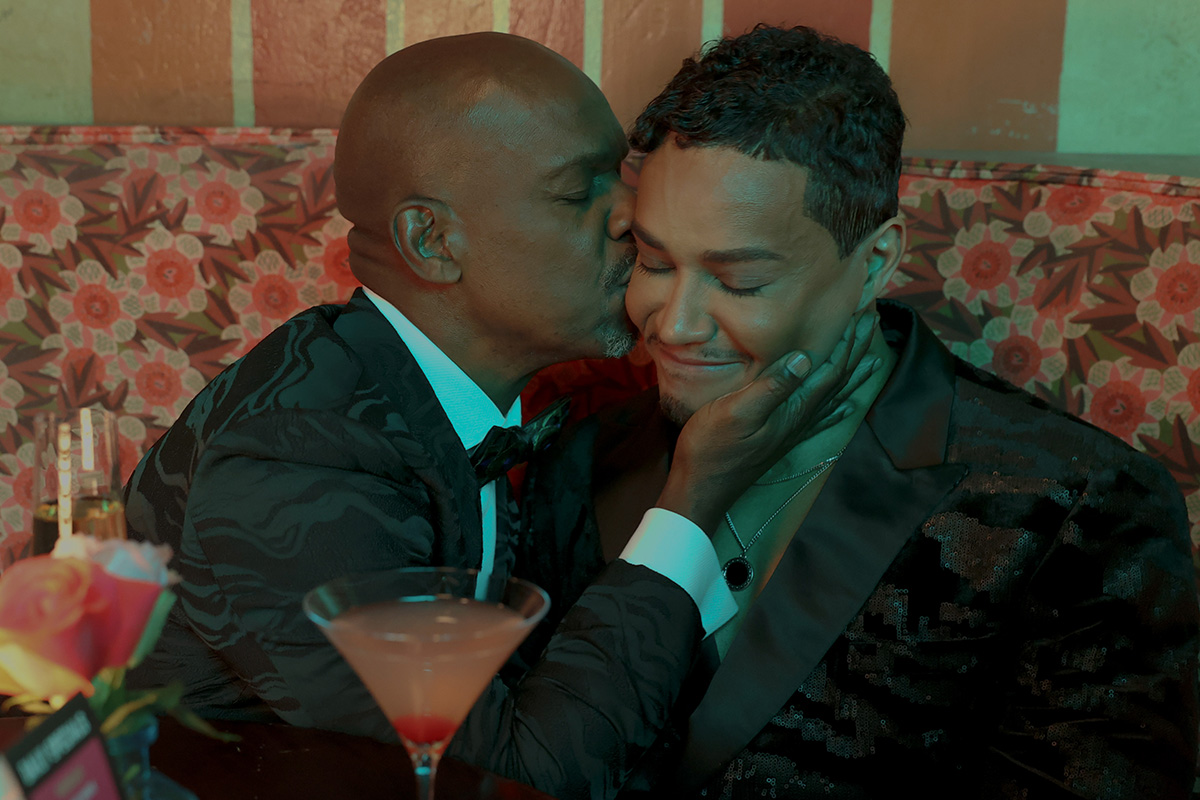
There’s no question that when Patrik-Ian Polk’s series “Noah’s Arc” premiered on Logo 20 years ago, it was a groundbreaking creation. The story of a group of Black gay men and their wonderful friendship. The titular arc was that of the cute main character, Noah (Darryl Stephens), and his close-knit circle of friends, including Chance played by gay actor Doug Spearman. This compelling and loving fraternity may, in fact, be what brought viewers back repeatedly, including a 2008 movie, “Noah’s Arc: Jumping the Broom,” as well as the 2020 “Noah’s Arc” short, and now, a new full-length feature “Noah’s Arc: The Movie,” debuting on Paramount+ on June 20. In the movie, filled with equal measures of laughs and tears, Chance, who has faced a devastating loss, finds his dependable friends there, ready to support and comfort him at a moment’s notice. I had the pleasure of speaking with Spearman the morning of the streaming premiere of “Noah’s Arc: The Movie.”
WASHINGTON BLADE: Doug, since the early 2000s, when the “Noah’s Arc” series premiered on Logo, you have been playing the character of Chance, including in the latest installment, “Noah’s Arc: The Movie.” What was it about Chance that appealed to you as an actor?
SPEARMAN: When Patrik (-Ian Polk) called me to ask me to play him (Chance), I was at JFK airport in the baggage claim, waiting for a suitcase. He explained what the part was. The thing that stuck out to me was the fact that Chance was in a long-term relationship with another Black man. And, they had a child; they had a 4-year-old daughter named Kenya. I had never seen two Black gay men raise a child on TV before. I thought it was the most revolutionary thing I’d ever seen. I immediately thought I’ve got to do this because that was something nobody had seen. I thought it was incredibly important to take the part.
BLADE: “Noah’s Arc: The Movie” was, once again, written and directed by Patrik-Ian Polk, who you just mentioned, is the creator of the entire franchise. What’s the secret to your long-standing working relationship?
SPEARMAN: [Laughs] the whole team, all of us, are like a band of brothers. We fight like brothers, we come together like brothers, we hash things out, we talk, because we’re all very different from our characters. I think the challenge of playing these guys and then uplifting these men, playing a part, especially something written by Patrik, is like solving a math equation. There’s always a challenge that’s enjoyable for me as an actor: to try to find out what it is that Patrik wants, and then how do I do it.
BLADE: I think you do a very good job of it.
SPEARMAN: Thank you very much
BLADE: In the years between “Jumping the Broom” and the new full-length movie, many changes have occurred, and the story addresses some of them, including gay widowhood, which is something that the aging community is now confronting, as well as mental health issues. Please say a few words about how you approached those subjects in the new movie.
SPEARMAN: I had a lot of loss in my life, right before we started shooting. Two months before we started shooting the first series, my mother died. I was going through the grief process through that whole first season. Since then, I’ve lost a lot of people in my life. In fact, when we started shooting the second season, the second week we were shooting, my ex died of a heart attack. I was having to fold that into what I was doing with my life on the set and off the set. You’ve got to show up and you’ve got to do your work. The first two seasons of “Noah’s Arc” are always tinged with the memory of grief. So, when I had to deal with the death that Chance faces (in the new movie), which is a significant death in his life, it wasn’t that hard to reach back, especially the scene in the graveyard. It was something that I unfortunately could pull from personal experience.
BLADE: Shifting gears, the movie features delightful cast surprises, including Jasmine Guy and TS Madison. Did you have a chance to interact with either or both when they were on set?
SPEARMAN: No, I didn’t have any scenes with Jasmine, and I missed her. I wish I had gotten to see her because I actually got to direct Jasmine for a CBS promo shoot for “Queen,” back in the early ‘90s. I had a huge crush on her when she was on “A Different World.” So, I really would have liked to reconnect. But TS and I got to see each other every day because I was in all her scenes. It was extraordinary being around somebody like that. That is one outspoken woman!
BLADE: Even though Beyoncé never makes an appearance in the movie, there’s a lot of talk about her. Would you say you are a Beyoncé fan?
SPEARMAN: Yes! I’m breathing! Yes, I’m a Beyoncé fan. I actually got the chance to meet her. I knew her mom. Her mom was extraordinary to me. She is in the second movie I directed. She also gave us a wedding gown to use in the very first scene of the movie. That family is extraordinarily important to me. Not only just to be a fan, but to be somebody who’s gotten to know them and work with them and see how hard they work. I don’t think anybody works as hard as Tina or Beyoncé.
BLADE: There was a recent news item about gay actor Benito Skinner of the Amazon Prime series “Overcompensating” being told not to bother auditioning for straight roles. As an out actor yourself, how important do you think it is for queer characters to be portrayed by queer actors, and vice versa?
SPEARMAN: Being queer is a multifaceted identity. There’s no one kind of queer person. I think finding the best actor that’s your first circle of casting. I think one of the joys about being an actor is that you get to play different parts. I play straight guys all the time. Dads and husbands and things like that. I think a lot of people are told not to do it. In fact, I wouldn’t be Chance if the actor who was originally cast as Chance hadn’t been pulled out of the series by his agents because they didn’t want him to play a gay character.
BLADE: That’s amazing! Thank you for sharing that. Without giving away too much, the ending of the movie is a little ambiguous, even ending with a question mark. If there was a “Noah’s Arc: The Movie” sequel, would you come back for that?
SPEARMAN: Yeah! A lot of it would depend on what Chance’s journey is going to be like. Patrik and I have conversations like that all the time. He’s very interested and supportive of input. I hope I would be, as we all would be, part of the creative growth with these characters. They live in Patrik’s head, and he writes them, but we’re the ones who have to flesh them out. It’s a conversation, it’s always a conversation.
BLADE: You are currently performing in Molière’s “The Imaginary Invalid” as part of the New Orleans Shakespeare Festival at Tulane. What has this experience been like for you?
SPEARMAN: It’s extraordinary! I started on stage when I was seven. There’s nothing like working with a live audience and having that immediacy. I’m working with an extraordinarily talented cast in a really great play, and I have some of the best scene partners I could ever want.
BLADE: Are there any upcoming film or TV projects you’d like to mention?
SPEARMAN: I’m still a writer, and I’m still a director, and I’ve still got scripts that I would like to make. I have a little something that’s a cross between “Treme” and “Bridgerton” that I want to do. I’m always trying to figure out what the next thing is.
a&e features
Visit Cambridge, a ‘beautiful secret’ on Maryland’s Eastern Shore
New organization promotes town’s welcoming vibe, LGBTQ inclusion
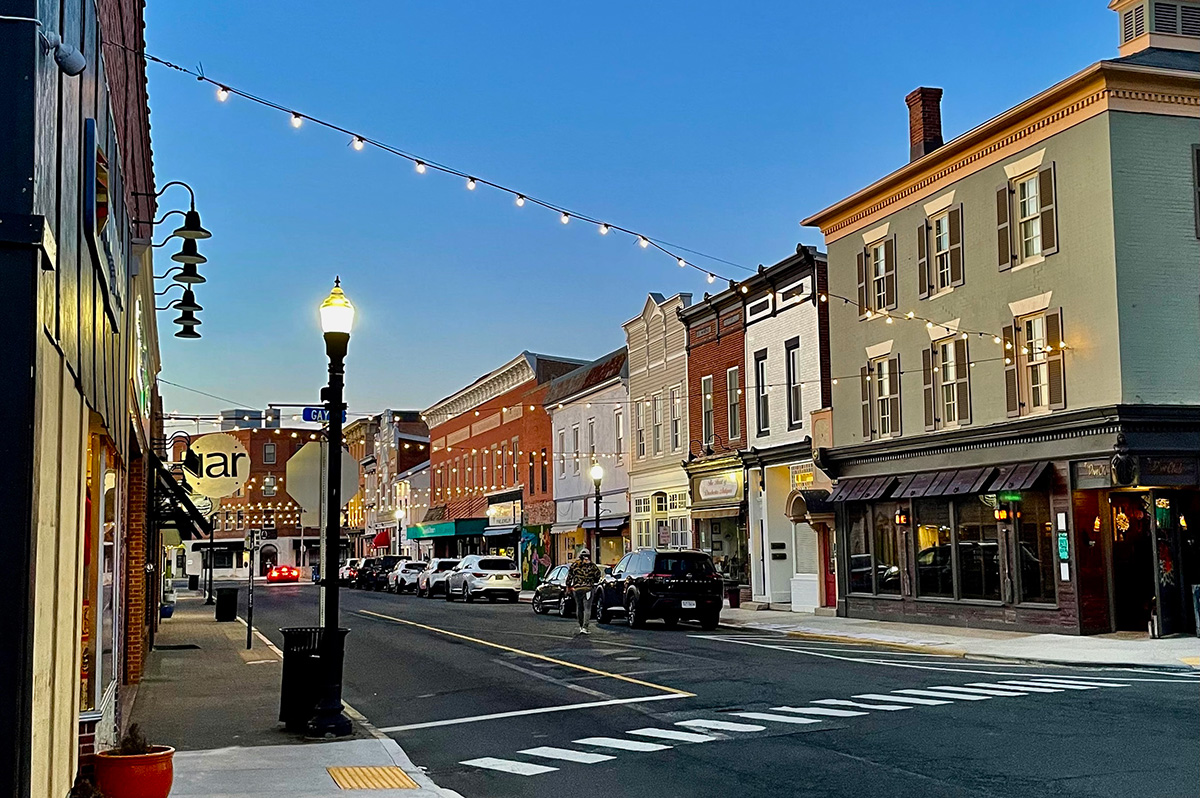
CAMBRIDGE, Md. — Driving through this scenic, historic town on Maryland’s Eastern Shore, you’ll be charmed by streets lined with unique shops, restaurants, and beautifully restored Victorian homes. You’ll also be struck by the number of LGBTQ Pride flags flying throughout the town.
The flags are a reassuring signal that everyone is welcome here, despite the town’s location in ruby red Dorchester County, which voted for Donald Trump over Kamala Harris by a lopsided margin. But don’t let that deter you from visiting. A new organization, Proudly Cambridge, is holding its debut Pride event this weekend, touting the town’s welcoming, inclusive culture.
“We stumbled on a beautiful secret and we wanted to help get the word out,” said James Lumalcuri of the effort to create Proudly Cambridge.
The organization celebrates diversity, enhances public spaces, and seeks to uplift all that Cambridge has to share, according to its mission statement, under the tagline “You Belong Here.”
The group has so far held informal movie nights and a picnic and garden party; the launch party is June 28 at the Cambridge Yacht Club, which will feature a Pride celebration and tea dance. The event’s 75 tickets sold out quickly and proceeds benefit DoCo Pride.
“Tickets went faster than we imagined and we’re bummed we can’t welcome everyone who wanted to come,” Lumalcuri said, adding that organizers plan to make “Cheers on the Choptank” an annual event with added capacity next year.
One of the group’s first projects was to distribute free Pride flags to anyone who requested one and the result is a visually striking display of a large number of flags flying all over town. Up next: Proudly Cambridge plans to roll out a program offering affirming businesses rainbow crab stickers to show their inclusiveness and LGBTQ support. The group also wants to engage with potential visitors and homebuyers.
“We want to spread the word outside of Cambridge — in D.C. and Baltimore — who don’t know about Cambridge,” Lumalcuri said. “We want them to come and know we are a safe haven. You can exist here and feel comfortable and supported by neighbors in a way that we didn’t anticipate when we moved here.”
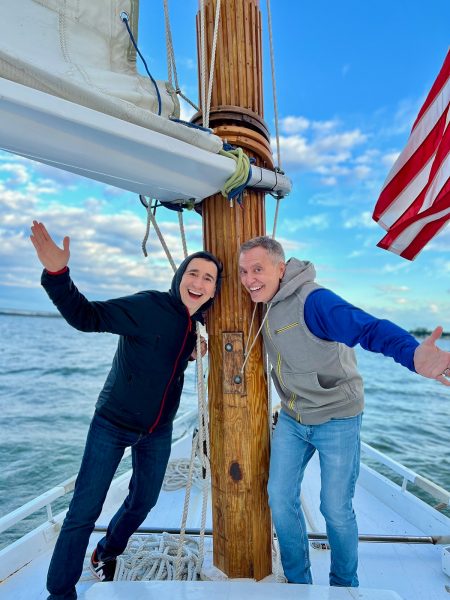
Lumalcuri, 53, a federal government employee, and his husband, Lou Cardenas, 62, a Realtor, purchased a Victorian house in Cambridge in 2021 and embarked on an extensive renovation. The couple also owns a home in Adams Morgan in D.C.
“We saw the opportunity here and wanted to share it with others,” Cardenas said. “There’s lots of housing inventory in the $300-400,000 range … we’re not here to gentrify people out of town because a lot of these homes are just empty and need to be fixed up and we’re happy to be a part of that.”
Lumalcuri was talking with friends one Sunday last year at the gazebo (affectionately known as the “gayzebo” by locals) at the Yacht Club and the idea for Proudly Cambridge was born. The founding board members are Lumalcuri, Corey van Vlymen, Brian Orjuela, Lauren Mross, and Caleb Holland. The group is currently working toward forming a 501(c)3.
“We need visibility and support for those who need it,” Mross said. “We started making lists of what we wanted to do and the five of us ran with it. We started meeting weekly and solidified what we wanted to do.”
Mross, 50, a brand strategist and web designer, moved to Cambridge from Atlanta with her wife three years ago. They knew they wanted to be near the water and farther north and began researching their options when they discovered Cambridge.
“I had not heard of Cambridge but the location seemed perfect,” she said. “I pointed on a map and said this is where we’re going to move.”
The couple packed up, bought a camper trailer and parked it in different campsites but kept coming back to Cambridge.
“I didn’t know how right it was until we moved here,” she said. “It’s the most welcoming place … there’s an energy vortex here – how did so many cool, progressive people end up in one place?”
Corey van Vlymen and his husband live in D.C. and were looking for a second home. They considered Lost River, W.Va., but decided they preferred to be on the water.
“We looked at a map on both sides of the bay and came to Cambridge on a Saturday and bought a house that day,” said van Vlymen, 39, a senior scientist at Booz Allen Hamilton. They’ve owned in Cambridge for two years.
They were drawn to Cambridge due to its location on the water, the affordable housing inventory, and its proximity to D.C.; it’s about an hour and 20 minutes away.
Now, through the work of Proudly Cambridge, they hope to highlight the town’s many attributes to residents and visitors alike.
“Something we all agree on is there’s a perception problem for Cambridge and a lack of awareness,” van Vlymen said. “If you tell someone you’re going to Cambridge, chances are they think, ‘England or Massachusetts?’”
He cited the affordability and the opportunity to save older, historic homes as a big draw for buyers.
“It’s all about celebrating all the things that make Cambridge great,” Mross added. “Our monthly social events are joyful and celebratory.” A recent game night drew about 70 people.
She noted that the goal is not to gentrify the town and push longtime residents out, but to uplift all the people who are already there while welcoming new visitors and future residents.
They also noted that Proudly Cambridge does not seek to supplant existing Pride-focused organizations. Dorchester County Pride organizes countywide Pride events and Delmarva Pride was held in nearby Easton two weeks ago.
“We celebrate all diversity but are gay powered and gay led,” Mross noted.
To learn more about Proudly Cambridge, visit the group on Facebook and Instagram.
What to see and do
Cambridge, located 13 miles up the Choptank River from the Chesapeake Bay, has a population of roughly 15,000. It was settled in 1684 and named for the English university town in 1686. It is home to the Harriet Tubman Museum, mural, and monument. Its proximity to the Blackwater National Wildlife Refuge makes it a popular stop for birders, drawn to more than 27,000 acres of marshland dubbed “the Everglades of the north.”
The refuge is walkable, bikeable, and driveable, making it an accessible attraction for all. There are kayaking and biking tours through Blackwater Adventures (blackwateradventuresmd.com).
Back in town, take a stroll along the water and through historic downtown and admire the architecture. Take in the striking Harriet Tubman mural (424 Race St.). Shop in the many local boutiques, and don’t miss the gay-owned Shorelife Home and Gifts (421 Race St.), filled with stylish coastal décor items.
Stop for breakfast or lunch at Black Water Bakery (429 Race St.), which offers a full compliment of coffee drinks along with a build-your-own mimosa bar and a full menu of creative cocktails.
The Cambridge Yacht Club (1 Mill St.) is always bustling but you need to be a member to get in. Snapper’s on the water is temporarily closed for renovations. RaR Brewing (rarbrewing.com) is popular for craft beers served in an 80-year-old former pool hall and bowling alley. The menu offers burgers, wings, and other bar fare.
For dinner or wine, don’t miss the fantastic Vintage 414 (414 Race St.), which offers lunch, dinner, wine tasting events, specialty foods, and a large selection of wines. The homemade cheddar crackers, inventive flatbreads, and creative desserts (citrus olive oil cake, carrot cake trifle) were a hit on a recent visit.
Also nearby is Ava’s (305 High St.), a regional chain offering outstanding Italian dishes, pizzas, and more.
For something off the beaten path, visit Emily’s Produce (22143 Church Creek Rd.) for its nursery, produce, and prepared meals.
“Ten minutes into the sticks there’s a place called Emily’s Produce, where you can pay $5 and walk through a field and pick sunflowers, blueberries, you can feed the goats … and they have great food,” van Vlymen said.
As for accommodations, there’s the Hyatt Regency Chesapeake Bay (100 Heron Blvd. at Route 50), a resort complex with golf course, spa, and marina. Otherwise, check out Airbnb and VRBO for short-term rentals closer to downtown.
Its proximity to D.C. and Baltimore makes Cambridge an ideal weekend getaway. The large LGBTQ population is welcoming and they are happy to talk up their town and show you around.
“There’s a closeness among the neighbors that I wasn’t feeling in D.C.,” Lumalcuri said. “We look after each other.”
a&e features
James Baldwin bio shows how much of his life is revealed in his work
‘A Love Story’ is first major book on acclaimed author’s life in 30 years

‘Baldwin: A Love Story’
By Nicholas Boggs
c.2025, FSG
$35/704 pages
“Baldwin: A Love Story” is a sympathetic biography, the first major one in 30 years, of acclaimed Black gay writer James Baldwin. Drawing on Baldwin’s fiction, essays, and letters, Nicolas Boggs, a white writer who rediscovered and co-edited a new edition of a long-lost Baldwin book, explores Baldwin’s life and work through focusing on his lovers, mentors, and inspirations.
The book begins with a quick look at Baldwin’s childhood in Harlem, and his difficult relationship with his religious, angry stepfather. Baldwin’s experience with Orilla Miller, a white teacher who encouraged the boy’s writing and took him to plays and movies, even against his father’s wishes, helped shape his life and tempered his feelings toward white people. When Baldwin later joined a church and became a child preacher, though, he felt conflicted between academic success and religious demands, even denouncing Miller at one point. In a fascinating late essay, Baldwin also described his teenage sexual relationship with a mobster, who showed him off in public.
Baldwin’s romantic life was complicated, as he preferred men who were not outwardly gay. Indeed, many would marry women and have children while also involved with Baldwin. Still, they would often remain friends and enabled Baldwin’s work. Lucien Happersberger, who met Baldwin while both were living in Paris, sent him to a Swiss village, where he wrote his first novel, “Go Tell It on the Mountain,” as well as an essay, “Stranger in the Village,” about the oddness of being the first Black person many villagers had ever seen. Baldwin met Turkish actor Engin Cezzar in New York at the Actors’ Studio; Baldwin later spent time in Istanbul with Cezzar and his wife, finishing “Another Country” and directing a controversial play about Turkish prisoners that depicted sexuality and gender.
Baldwin collaborated with French artist Yoran Cazac on a children’s book, which later vanished. Boggs writes of his excitement about coming across this book while a student at Yale and how he later interviewed Cazac and his wife while also republishing the book. Baldwin also had many tumultuous sexual relationships with young men whom he tried to mentor and shape, most of which led to drama and despair.
The book carefully examines Baldwin’s development as a writer. “Go Tell It on the Mountain” draws heavily on his early life, giving subtle signs of the main character John’s sexuality, while “Giovanni’s Room” bravely and openly shows a homosexual relationship, highly controversial at the time. “If Beale Street Could Talk” features a woman as its main character and narrator, the first time Baldwin wrote fully through a woman’s perspective. His essays feel deeply personal, even if they do not reveal everything; Lucian is the unnamed visiting friend in one who the police briefly detained along with Baldwin. He found New York too distracting to write, spending his time there with friends and family or on business. He was close friends with modernist painter Beauford Delaney, also gay, who helped Baldwin see that a Black man could thrive as an artist. Delaney would later move to France, staying near Baldwin’s home.
An epilogue has Boggs writing about encountering Baldwin’s work as one of the few white students in a majority-Black school. It helpfully reminds us that Baldwin connects to all who feel different, no matter their race, sexuality, gender, or class. A well-written, easy-flowing biography, with many excerpts from Baldwin’s writing, it shows how much of his life is revealed in his work. Let’s hope it encourages reading the work, either again or for the first time.



